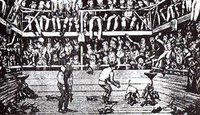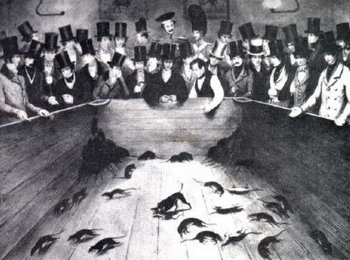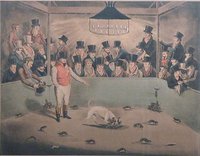 Rat Baiting Competition
Rat Baiting Competition
|
From Wikipedia the free encyclopedia, by MultiMedia |
 Rat Baiting Pit
Rat Baiting PitRat-baiting is a bloodsport involving the baiting of rats in a pit.
In 1835, the Parliament of the United Kingdom implemented an Act called the Humane Act, which prohibited the baiting of some animals such as the bull, bear and other large animals. However, rat baiting was not enforced and ratting competitions came to the forefront as a gambling sport.
Wentworth Day a follower of the sport of rat baiting, described his experience and atmosphere at one of the last old rat pits in London during those times.
 Rat Baiting Competition
Rat Baiting Competition
The officials included a referee and timekeeper. The pit was either covered above with wire mesh or additional security devices were installed on the walls to prevent the rats from escaping.
There was a weight handicap for each Dog. The competing Dog had to kill as many rats as the number of pounds the Dog weighed, within a specific preset time. The prescribed number of rats was released and the Dog was put in the ring. The clock started the moment the Dog touched the ground. When the Dog seized the last rat, his owner grabbed it and the clock stopped.
Rats that were thought still to be alive were laid out on the table in a circle before the referee. The referee then struck the animals three times on the tail with a stick. If a rat managed to crawl out of the circle, it was considered to be alive. The Dog had to go back in the ring with these rats and kill them. The new time was added to the original time.
A combination of the quickest time, the number of rats and the Dog's weight decided the victory. A rate of five seconds per rat killed was considered quite satisfactory; fifteen rats in a minute was an excellent result.
Consider catching, lifting, biting-to-death and dropping a rat within four seconds and seizing the next one while the first is falling to the ground. In addition, the cornered rats will attack and can deliver a very painful bite. It was not uncommon to see a ratter left with only one eye in its retirement.
Before the contest could begin there was a requirement for the capture of potentially thousands of rats. The rat-catcher, would be called upon to fulfill this requirement. A famous rat-catcher from Victorian England was Jack Black.
Rat killing is a very specialized art. For this purpose you needed not only a brave Dog, which did not shy away from rat bites, but one of especially great speed. The true rat killer bites once, drops the rat, bites again, drops again and so on.
Some Dogs shake the caught rat to prevent it from biting. A Dog that wastes its time with shaking has absolutely no chance of winning a rat killing contest, which is decided chiefly on time. The successful rat killer seizes the rat between head and shoulder, which prevents the rat from biting and kills the rat immediately with a sharp bite.
The ratting Dogs were typically Terrier breeds, which included, but not limited too, the Bull and Terrier, Bull Terrier, Fox Terrier, Jack Russell Terrier, Rat Terrier, Manchester Terrier and Staffordshire Bull Terrier. The degree of care used in breeding these ratters is clear in their pedigree with good breeding leading to increased business opportunities. Successful breeders were highly regarded and famous in those times.
 Billy, the celebrated Rat Killing Dog, London, Circa 1823
Billy, the celebrated Rat Killing Dog, London, Circa 1823
A celebrated Bull and Terrier named "Billy" weighing approximately 26 pounds, had a proud fighting history and the pedigree reflects the build-up over a period of years. The Dog was owned by Charles Dew and was bred by the famous breeder James Yardington. On the paternal side is "Old Billy" from the kennel of John Tattersal from Woollen under Edge, Gloucestershire and was descended from the best line of all Old English BullDogs. On the maternal side, is "Yardington's Sal" descended from the Curley line. The pedigree of all these Dogs can be traced back more than forty years and there are numerous old accounts about them.
The October 1822, edition of The Sporting Magazine provided descriptions of two rat pit matches with Billy, quoted as follows:
Billy's best competition results are as follows:
| Date | Rats Killed | Time | Time per Rat | |
|---|---|---|---|---|
| 1820-??-?? | 20 | 1 minute, 11 seconds | 4.6 seconds | |
| 1822-09-03 | 100 | 8 minutes, 45 seconds | 5.2 seconds | |
| 1822-10-24 | 100 | 7 minutes, 17 seconds | 4.4 seconds | |
| 1822-11-13 | 100 | 6 minutes, 25 seconds | 3.4 seconds | |
| 1823-04-22 | 100 | 5 minutes, 30 seconds | 3.3 seconds | * Record |
| 1823-08-05 | 120 | 8 minutes, 20 seconds | 4.1 seconds |
Billy's career was crowned on April 22, 1823, when a world record was set with a hundred rats killed in five-and-a-half minutes. This record stood until 1862 when it was claimed by another ratter named "Jacko". Billy continued in the rat pit until old age reportedly with only one eye and two teeth remaining.
According to the Sporting Chronicle Annual, the world record in rat killing is held by a black and tan Bull Terrier named "Jacko" weighing about thirteen pounds and owned by Jemmy Shaw. Jacko had the following contest results:
| Date | Rats Killed | Time | Time per Rat | |
|---|---|---|---|---|
| 1861-08-08 | 25 | 1 minute, 28 seconds | 3.5 seconds | |
| 1862-07-29 | 60 | 2 minutes, 42 seconds | 2.7 seconds | * Record |
| 1862-05-01 | 100 | 5 minutes, 28 seconds | 3.3 seconds | * Record |
| 1862-06-10 | 200 | 14 minutes, 37 seconds | 4.4 seconds | |
| 1862-05-01 | 1000 | in less than 100 minutes | 6.0 seconds |
Jacko set two world records, the first on July 29, 1862, with a killing time of 2.7 seconds per rat and the second on May 1, 1862, with his fight against one hundred rats, where Jacko worked two seconds faster than the previous world record holder "Billy". The feat of killing 1,000 rats took place over a ten-week period, with one hundred rats being killed each week ending on May 1, 1862.
The last public competition took place in Leicester in 1912. The owner was prosecuted, fined and had to give a promise to the court that he would never again promote such entertainment. Toward the latter half of Queen Victoria's reign, a more humane attitude to the canine race gradually emerged, with her Majesty's love of animals setting the example. Baiting sports diminished in popularity and the exhibition of Dogs slowly replaced the attractions of the Dog pit.
Dogs, made by MultiMedia | Free content and software
This guide is licensed under the GNU Free Documentation License. It uses material from the Wikipedia.